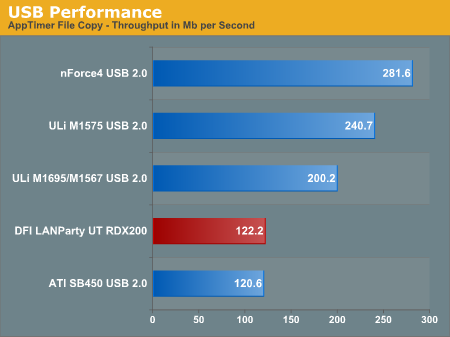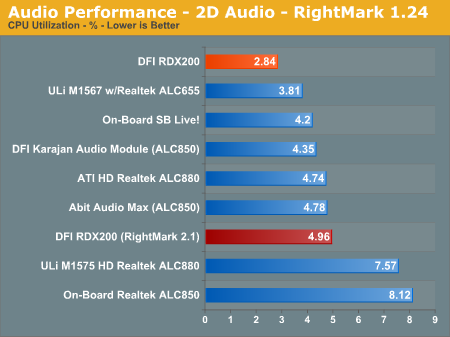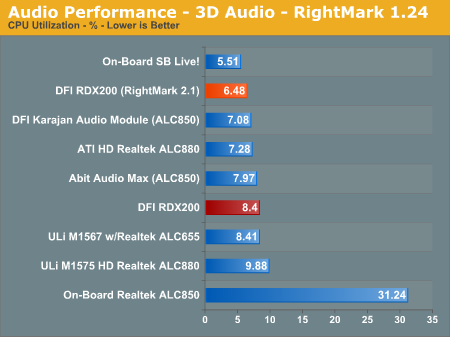DFI LANParty UT RDX200: ATI’s Crossfire AMD for the Bleeding Edge
by Wesley Fink on October 18, 2005 11:03 AM EST- Posted in
- Motherboards
Performance of Features
When you receive a board Friday afternoon that will go on sale Tuesday morning, there is sometimes just not enough time to complete all the tests that you initially planned. In the interest of bringing you the most significant test results on the DFI RDX200, we concentrated on two areas of interest, specifically USB Performance and CPU utilization of the Karajan audio module.
For additional information on the performance of other Storage, Ethernet, and Firewire, please go to other recent ATI Rx480/482 reviews at "ATI's Crossfire: Best Overclocker on the Market?" and "Sapphire PURE Innovation - ATI's Chipset for the AMD Enthusiast". The performance of the feature accessory chips present on the DFI RDX200 are tested in those reviews.
USB Performance
USB has been a problem area for the ATI SB450 chipset, so we decided to see if anything had changed. We ran our standard USB throughput test on the DFI using an external USB hard drive.
Our test method uses a RAM disk as our "server", since memory removed almost all overhead from the serving end. We also managed to turn off disk caching on the USB and Firewire side by setting up the drives for "quick disconnect" and our results were then consistent over many test runs.
We use just 1GB of fast 2-2-2 system memory set up as a 450MB RAM disk and 550MB of system memory. Our stock file is the SPECviewPerf install file, which is 432,533,504 bytes (412.4961MB). After copying this file to our RAM disk, we measured the time for writing from the RAM disk to our external USB 2.0 or Firewire 400 or Firewire 800 drive using a Windows timing program written for AnandTech by our own Jason Clark. The copy times in seconds were then converted into Megabits per second (Mb) to provide a convenient means of comparing throughput. Higher Rates, therefore, mean better performance.
There is an alternative in the ULi M1575 southbridge, which we recently tested. The ULi SB provides competitive USB performance and the SATA2 ports, which are missing from the ATI SB450 - and it is available today. We asked DFI why they chose the SB450 instead and they responded that the design work for the RDX200 was far along when the M1575 became an alternative. DFI also pointed out that M1575 and SB450 are not pin-compatible, thus making a last minute change in southbridge to be a very costly option. The SB600 should be pin-compatible with SB450, as M1575 is pin-compatible with M1573. When the SB600 is available, DFI will use the SB600 instead. They may also consider an SB change in their upcoming ATI dual x16 motherboard.
Audio Performance
For audio testing, we used Rightmark 3D Sound CPU utilization test, which is the same benchmark run in our earlier nForce4 SLI and Ultra roundups. This benchmark measures the overhead or CPU utilization required by a codec or hardware audio chip. We tested performance both with the earlier version 1.24 that we had used for past testing and the latest version 2.1. As you will see, 2.1 does yield different performance numbers.
It is very important to point out that the DFI LANParty UT RDX200 is the first Athlon 64 retail motherboard to deliver Azalia High Definition audio. Those who have been complaining about the poor AC'97 audio present on most AMD boards should be very pleased to find Azalia HD on the ATI chipset boards.
DFI claims that the Karajan module lowers noise using an on-board audio solution. We did some subjective listening tests with the DFI's version of Azalia HD through a Dolby amplifier and a 5.1 speaker setup. We really couldn't hear a huge improvement over our last listening tests of ATI Azalia HD. Perhaps that was because our last experience with Azalia HD on AMD was so good. HD really is in a completely different league from the other audio solutions that we have tested on Athlon 64. Noise was virtually non-existent, and imaging and depth were superb when listening to demanding CDs. The same CD sounded thin, noisy, and artificial through a more common ALC850 fed to the same Dolby amp and 5.1 speakers. This is not to say that the Azalia HD is at the same level as the very best audio cards, but it is a lot closer than you might think.
When you receive a board Friday afternoon that will go on sale Tuesday morning, there is sometimes just not enough time to complete all the tests that you initially planned. In the interest of bringing you the most significant test results on the DFI RDX200, we concentrated on two areas of interest, specifically USB Performance and CPU utilization of the Karajan audio module.
For additional information on the performance of other Storage, Ethernet, and Firewire, please go to other recent ATI Rx480/482 reviews at "ATI's Crossfire: Best Overclocker on the Market?" and "Sapphire PURE Innovation - ATI's Chipset for the AMD Enthusiast". The performance of the feature accessory chips present on the DFI RDX200 are tested in those reviews.
USB Performance
USB has been a problem area for the ATI SB450 chipset, so we decided to see if anything had changed. We ran our standard USB throughput test on the DFI using an external USB hard drive.
Our test method uses a RAM disk as our "server", since memory removed almost all overhead from the serving end. We also managed to turn off disk caching on the USB and Firewire side by setting up the drives for "quick disconnect" and our results were then consistent over many test runs.
We use just 1GB of fast 2-2-2 system memory set up as a 450MB RAM disk and 550MB of system memory. Our stock file is the SPECviewPerf install file, which is 432,533,504 bytes (412.4961MB). After copying this file to our RAM disk, we measured the time for writing from the RAM disk to our external USB 2.0 or Firewire 400 or Firewire 800 drive using a Windows timing program written for AnandTech by our own Jason Clark. The copy times in seconds were then converted into Megabits per second (Mb) to provide a convenient means of comparing throughput. Higher Rates, therefore, mean better performance.

There is an alternative in the ULi M1575 southbridge, which we recently tested. The ULi SB provides competitive USB performance and the SATA2 ports, which are missing from the ATI SB450 - and it is available today. We asked DFI why they chose the SB450 instead and they responded that the design work for the RDX200 was far along when the M1575 became an alternative. DFI also pointed out that M1575 and SB450 are not pin-compatible, thus making a last minute change in southbridge to be a very costly option. The SB600 should be pin-compatible with SB450, as M1575 is pin-compatible with M1573. When the SB600 is available, DFI will use the SB600 instead. They may also consider an SB change in their upcoming ATI dual x16 motherboard.
Audio Performance
For audio testing, we used Rightmark 3D Sound CPU utilization test, which is the same benchmark run in our earlier nForce4 SLI and Ultra roundups. This benchmark measures the overhead or CPU utilization required by a codec or hardware audio chip. We tested performance both with the earlier version 1.24 that we had used for past testing and the latest version 2.1. As you will see, 2.1 does yield different performance numbers.



It is very important to point out that the DFI LANParty UT RDX200 is the first Athlon 64 retail motherboard to deliver Azalia High Definition audio. Those who have been complaining about the poor AC'97 audio present on most AMD boards should be very pleased to find Azalia HD on the ATI chipset boards.
DFI claims that the Karajan module lowers noise using an on-board audio solution. We did some subjective listening tests with the DFI's version of Azalia HD through a Dolby amplifier and a 5.1 speaker setup. We really couldn't hear a huge improvement over our last listening tests of ATI Azalia HD. Perhaps that was because our last experience with Azalia HD on AMD was so good. HD really is in a completely different league from the other audio solutions that we have tested on Athlon 64. Noise was virtually non-existent, and imaging and depth were superb when listening to demanding CDs. The same CD sounded thin, noisy, and artificial through a more common ALC850 fed to the same Dolby amp and 5.1 speakers. This is not to say that the Azalia HD is at the same level as the very best audio cards, but it is a lot closer than you might think.










48 Comments
View All Comments
Skoad - Friday, October 21, 2005 - link
Board just came in stock at newegg for $209+5 shipping.Also what psu was used in this test. I read somewhere that the board needs an 8pin connection from the psu and that very few psu's have this right now.
I can't seem to find where I read this at atm.
Wesley Fink - Friday, October 21, 2005 - link
We use the OCZ 520W as a standard bench PSU. It has both 4 and 8-pin 12V connectors. 8-pin slots will also work with 4-pin 12V plugs.Zoomer - Wednesday, October 19, 2005 - link
Will there be a value ATi board?I don't forsee myself getting a xfire solution, ever.
smaky - Thursday, October 20, 2005 - link
Guess who is getting one this week? hiihihihiihih x850?danidentity - Wednesday, October 19, 2005 - link
You make no comment on the stability of this board, how is it?cryptonomicon - Wednesday, October 19, 2005 - link
Sorry, but I can't help but ask why the gaming performance graphs were not all done on the same graphics card. Initially I thought WOW THIS NEW ATI CHIPSET IS MAD FAST but then I see it was using the 7800 gtx while all the other boards got 6800 ultras... WTF?What the heck is going on? Was the scientific method forgotten or something? This is a let down.
rjm55 - Wednesday, October 19, 2005 - link
I'm always amazed in reading AT Comments that those who complain loudest are the ones who don't even bother to READ the review. I may not always agree with Wesley's approach on a review, but I know his results are always documented clearly in the review, logical, and repeatable. In fact he is the reviewer at AT who is most careful to always document the components he tested with and the setups. Derek and Anand often leave you guessing how they tested and you have to ask to figure it out.If you had bothered to read the test setup you would have seen that the red bars are tests with the 6800 Ultra - the same used in every other compared board. The 7800GTX and Crossfire were BONUS results - for those who would be screaming "Why have you tested with the obsolete 6800 Ultra instead of the 7800GTX".
Please READ before you scream so your rants aren't a total waste of time.
JarredWalton - Wednesday, October 19, 2005 - link
Sorry to have to point this out, but assembling and testing a motherboard can take several days. The 7800GTX scores were there for reference, but 6800 Ultra was used as well (the red bar) to make scores comparable. It's not practical to go back and retest seven (or more) motherboards every time a new article needs to be published. If we don't include something like the 7800GTX, people wonder how that affects performance. Just look at the red bars for motherboard comparisons and the gold bar to see what a $500 (instead of $350) GPU will do. :)cryptonomicon - Wednesday, October 19, 2005 - link
nevermind, wesley made no error, just me :D the board using the 6800u in red is the direct comparison (which it said in the article, albeit not on the gaming performance page). must have been too late at night or i was just too dumb to see it! excellent article as always.cryptonomicon - Wednesday, October 19, 2005 - link
hats off to DFI, this board is wicked fast. i am curious though as to how it will sell given the high price.